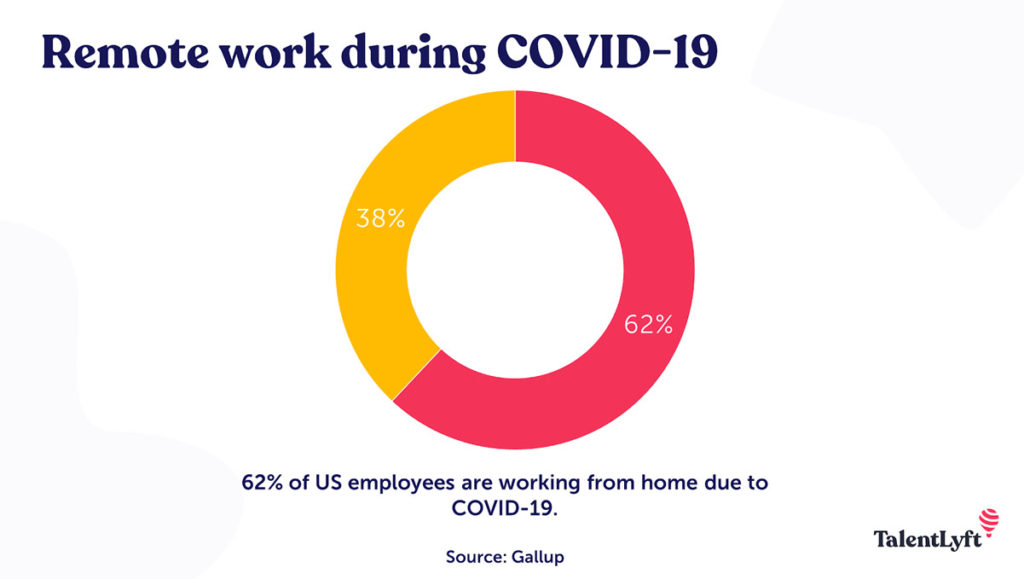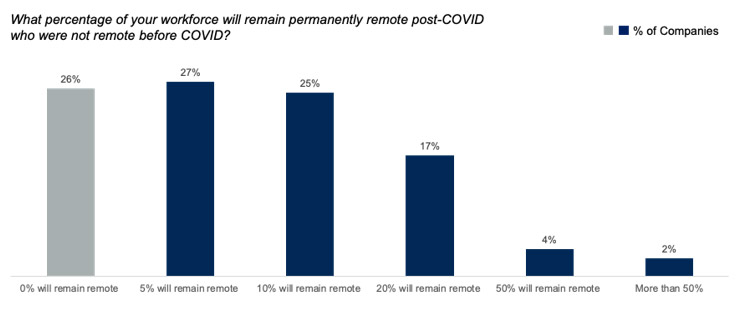5 Essential components of an effective work from home policy
Have you recently made the decision to go remote? This article walks through 5 key things every organization should include in their work from home policy.
 Owen Baker
Owen Baker
Warning: Undefined array key "category" in /www/hypercontext_216/public/wp-content/themes/Soapbox/hype-files/sections/article/content.php on line 10
Before the COVID-19 pandemic, only around 7% of US employees worked from a “flexible workplace,” according to the 2019 National Compensation Survey of the federal Bureau of Labor Statistics. That number ballooned to 62%, according to a Gallup survey conducted between March 30 and April 2, 2020:

Interestingly, the data suggests this change may be more permanent than we initially imagined, considering that 74% of companies plan to allow more remote working arrangements even after the pandemic is over.

Therefore, it makes sense for managers to create policies that take this new reality into account. In this article, we’ll explore the five essential components of an effective work from home policy, including:
But first, what are the benefits of working from home?
Benefits of working from home
It’s important to note that working from home is not going to work for every company. For those that rely on a physical space, like beauty salons, restaurants, and warehouses, remote work will never be an option. However, a large section of the economy could see benefits from adopting a work from home policy.
As a business owner, some notable benefits will include things like:
- Cost savings on office space
- The ability to hire qualified candidates without geographic constraints
A remote or flexible working environment doesn’t just benefit employers, it also benefits the employees too. Let’s examine some of these benefits.
1. Flexible schedule
Working from home gives you an opportunity for a flexible work schedule.
“The flexibility to work a non-linear workday and fit my work into my life — as opposed to the other way around — is a tremendous blessing.”
-Darren Murph, Head of Remote at GitLab
Depending on how you want to structure your work hours, you can set up core working hours of the day, or you can operate under a nonlinear workday. A big factor in the structure (or lack thereof) of your working hours is where your team is located. If you’re a remote team that’s located within the same or similar time zone, it might be easier to run with having core work hours. However, if you’re distributed across the world, people’s schedules will be all over the place.
This isn’t necessarily a bad thing though, so long as there are the proper communication procedures in place that provide the team with the knowledge they need to know when people are available (and when they’re not).
Structure your day around your life not your work
Working from home also allows greater flexibility around breaks and mealtimes. If you prefer to have breakfast later in the day, you can go and grab it from the kitchen whenever is convenient. And if your partner or children are at home with you, you can break at a time that allows you to properly care and spend time with your kids.
Being able to follow our natural rhythms for eating and sleeping patterns is good for physical and mental health, as well as increasing productivity.
2. No physical travel to work
If you’re working from home, you can save a substantial amount of money simply by removing the need to commute. According to Dollar Sprout, remote workers can save up to $7000 per year in the US! Plus, the environment benefits from fewer cars on the road every day.
Apart from the dollar savings, remote employees will no longer have a reason to complain about rush-hour traffic. Gone are the days of being stuck for hours in traffic, packed like a sardine on the subway, or fighting for a cab. The only travel you have to worry about is those five steps from your bedroom to your home office.
3. More time with family
Avoiding the commute and long hours spent at the office means more time for your family. You might still be in front of your computer during work hours, but during your breaks, you can sneak in a game with your child or watch a TV show with your partner.
Working from home also makes it easier to juggle your various responsibilities. A flexible schedule and being physically present at home allows you to take your children to school and be there when they get home, pause from work to put a batch of laundry in the dryer, or cook a meal for your family.
5 Essential components of a work from home policy
Remote work will likely become an increasingly popular option in the coming years. If your company chooses to go 100% remote, or give employees the chance to work remotely one or more days a week, you will need to devise a work from home policy.
The absence of guidelines can create confusion. When employees don’t know what the manager’s expectations are, miscommunications and loss of productivity are more likely to occur. With that in mind, here are five essential components of a work from home policy that suits both the employees and the company.
1. Eligibility
Not everyone can work from home. Some jobs simply don’t allow for it (restaurant workers, retailers, plumbers, police officers, and so on). According to We Forum, only “knowledge workers” and people who do most of their work on computers can effectively work from home. That’s 24% of those in management, business, and finance, and 14% of “professional and related workers.” Therefore, consider who in your company structure is eligible for remote working based on the needs of the business.
Analyze your work model to decide which jobs can be done from home, and specify this clearly in your policy. It might also be possible to allow people in certain roles to work from home some of the time while reporting to the office when necessary.
I like this simple rule of thumb: If employees don’t need to interact directly with people on-site, they can work from home. Just make sure they have any equipment they need.
2. Schedule requirements
Your work from home policy should clearly outline the expectations you have in terms of employee availability. The nature of these expectations depends on your business needs.
You might require your employees to be on-call from 9 am to 5 pm. Or you might allow them to set their own work schedule, but require them to be available during certain core hours. If you have people living in different time zones, you’ll need to take those into consideration, too.
Being unclear about expectations can lead to misunderstandings. And these create confusion, resentment, and a loss of productivity.
3. Productivity measurements
Assessing work-from-home employees’ productivity is notoriously difficult if you do not have a clear and robust system in place.
There are many ways to measure productivity. You might monitor the hours worked, their output for the day, or some combination. Tracking time is relatively easy. There are lots of great employee time tracking tools on the market. Examples include Zoomshift, which we use at our company, and Clockify.
Alternatively, you might measure based on performance. Giving someone flexibility as long as they achieve the desired results is one option for certain employees. You’ll need to find the best balance for your company.
4. Managing communication
The ability to communicate effectively will play an important role in the success of your remote office. The problem with distance is there’s lots of opportunity for miscommunication. Your communication channels will likely be a mix of email, Slack, video, meeting agendas, and asynchronous channels. It’s important to communicate clearly and professionally at all times.
As well as outlining availability expectations, you should also specify the tools you expect your team to use to communicate. If you prefer to meet using specific video conferencing tools, like Google Hangouts or Zoom, include these requirements in your policy.
You should also outline the expectations around when each tool is used, such as:
- Google Hangouts for video calls
- Hypercontext for all meeting agendas including one-on-one, team, and async meetings
- Slack or Microsoft Teams for quick chats and major updates
- Asana or Monday for project updates
Don’t forget to take privacy into consideration, too. Many companies have stopped using certain tools for any discussions involving confidential or sensitive information due to privacy concerns.
Choose tools that are easy to install and use, and most importantly, easily integrated into your existing tech stack. You don’t want your employees to have to spend hours getting to grips with them!
5. Security
Security takes on an extra layer of complexity when employees work from home. A breach can be disastrous, so consider all eventualities and spell out the rules in your policy. For example, is the use of public wi-fi networks (such as those in coffee shops) acceptable, or must employees only use a secured, password-protected network at home?
In your policy, lay down some specific dos and don’ts. For example, sharing passwords is an absolute no-no, and it’s good practice to log out of all accounts at the end of every workday. Considering implementing a secure password manager like 1Password. You might also have additional measures in place such as two-factor authentication or stringent password security requirements. Employees should also be informed about how to improve device security.
The fewer touchpoints employees have with sensitive data, the less you will have to worry about security. Therefore, ensure that everyone has access only to what they need, and only for as long as is strictly necessary.
Working from home, the new normal
As the COVID-19 pandemic continues, business owners should assume working from home is the new normal for the foreseeable future. But as we’ve seen, it’s not a bad thing! Employees working from home can benefit from greater flexibility, a better work-life balance, and stronger physical and mental health. When employees are happy, they make customers happy and work harder. All of this ultimately spells success for the business.
Managers need to put rules and expectations in place to ensure that your employees and your company are protected. The absence of specific rules leads to confusion and miscommunication. Therefore, adopting a robust and clear policy is essential. If you include these five essential components in your policy and make every effort to be a great manager, your remote working policy will keep everyone happy and keep your company running smoothly.

Owen Baker is a content marketer for Voila Norbert, an online email verification tool. He has spent most of the last decade working online for a range of marketing companies. When he’s not busy writing, you can find him in the kitchen mastering new dishes.
Is your organization remote-ready?
What you should do next
Now that you've read this article, here are some things you should do:
- Our library of meeting agenda templates is designed to help you run more effective meetings.
- Learn more about Spinach and how it can help you run a high performing org.
- If you found this article helpful, please share it with others on Linkedin or X (Twitter)
